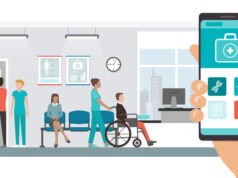
The United States is experiencing a mental health epidemic within the Covid-19 pandemic that is spiking substance use disorder (SUD) rates. February 2022 provisional data from the Centers for Disease Control and Prevention’s National Center for Health Statistics found that an estimated 104,288 people in the U.S. died of drug overdoses in the 12-month period ending September 2021.
To make matters worse, behavioral health providers are increasingly strapped for resources and are struggling to keep up with surging patient demands. At the same time, we are seeing increased awareness of behavioral health conditions that is helping to decrease stigma. This has led to more people seeking care; however, affordable and evidence-based care is often hard to find.
Recognizing that there is a need for a stronger system to facilitate access to behavioral health care, the federal government and state governments are stepping in. The American Rescue Plan Act of 2021, which became law in March 2021, included billions in support for life-saving mental health and substance use services. The legislation aims to improve behavioral health care by allotting $4 billion for programs that support the prevention and treatment for mental health and SUD. This includes Substance Abuse and Mental Health Services Administration (SAMHSA) Block Grants, Certified Community Behavioral Health Clinics (CCBHCs) expansion grants, Provider Relief Funds for those serving rural communities, and additional funding for SAMHSA and Health Resources and Services Administration (HRSA) programming.
While this legislation represents an important step forward, it also underscores the increasing need for the integration of a comprehensive behavioral health capacity management and referral technology solution across states. The benefits of a system such as this help health systems, payers, and state and county governments create a trusted treatment network to improve support and care delivery to patients in need, improving public health and enabling a whole person view for behavioral health treatment.
Barriers to whole person care in behavioral health
A key problem to better understanding a patient’s complete picture of health is that health data is siloed in different systems across the country. This means that healthcare providers, regardless of their specialty, do not always have access to the necessary health data needed to incorporate physical health into their overall behavioral health and health plans.
There are even more challenges for patient populations that are traditionally underserved and neglected. We should be able to track these high-risk individuals from a behavioral health perspective. For example, when they are admitted for an overdose, we should be able to alert their providers, clinicians, or care managers wherever they are located. If they don’t have a provider, they should be connected to definitive assessment and treatment. That way, they can get the care that they need upon emergency department (ED) release, when they are most vulnerable.
This can be done by identifying and tracking mental health and SUD inpatient and outpatient treatment, and social service resources, in a single network. This technology can track utilization and referral patterns at the organizational, regional, and state levels to help identify service gaps, inform policy and program design, and make more cost-effective use of resources. Most importantly, it should be integrated so that behavioral health providers can refer into primary care, primary care providers can refer back to behavioral health providers or to the ED, and primary care offices with behavioral health coordinators can use the system to follow up for continued care.
Solutions for a whole person view
There is now a thirst for real-time patient data with care transitions among clinicians and payers. Although many health institutions and providers do not currently have access to this critical care coordination information that could help save lives, healthcare information technology solutions are available to facilitate rapid provider referrals and feedback.
A recent example of whole person care in action is the Centers for Medicare and Medicaid Services (CMS) Interoperability and Patient Access Rule E-Notifications Condition of Participation (CoP), which required hospitals across the country to send real-time ADT notifications to all requesting post-acute providers, PCPs, and primary care entities, as of May 1, 2021. This provision was designed to help hospitals better serve their patients through improved care coordination and enhanced interoperability among providers. Healthcare providers that have integrated a CMS-compliant solution are now electronically notified whenever patients experience care events. They receive an in-patient e-notification about their patient and are informed if their patient is in the hospital with a behavioral health condition.
A step further: Building an infrastructure to support the future of crisis care at the community level
The federal government is also trying to standardize access to emergent behavioral healthcare across the U.S., which is absolutely necessary. Their goal is to put behavioral healthcare on par with physical healthcare. This is done by treating behavioral health emergencies in a similar way to physical emergencies. While the concept of crisis care and phone hotlines is not new, previous approaches to behavioral health crisis management were piecemeal in many communities. To avoid too many individuals falling through the cracks, states and communities need a comprehensive, integrated behavioral health crisis infrastructure to close gaps in care.
To make this happen, communities should make clinicians available to talk to patients in need, and they must have the ability to dispatch a mobile crisis team, the equivalent of an ambulance. Clinician can then assess patients onsite and take them to an ED or 24-hour crisis service for observation where, if needed, they can be moved to more intense care or outpatient care. This level of crisis support benefits patients by allowing urgent access to the care they need while also giving providers a broader view of their existing conditions and health needs.
The federal government has clued into this need for a system to pull treatment capacity, provide situational awareness regarding treatment availability, and enable digital referrals for whole person care. Yet, they need a technology to tie call lines as well as the clinicians’ electronic health record systems together – all necessary to support The National Suicide Hotline Designation Act. The act establishes “988” as the National Suicide Prevention Lifeline starting on July 16, 2022, requiring the Federal Communications Commission to designate “988” as the universal telephone number for a national suicide prevention and mental health crisis hotline.
With a crisis management technology infrastructure in place, crisis call center staff can communicate digitally with mobile crisis units and treatment providers, see treatment availability in real-time, and dispatch patients to handle crisis situations related to mental health and SUD. That way they can support collaboration between departments of behavioral health and development services, law enforcement agencies, hospitals, and healthcare facilities, and various other stakeholders.
Linking into health data for whole person care
In closing, to collectively improve access to behavioral health services, we must look at it from a data perspective. Providers, treatment organizations, referring organizations, health systems, managed care organizations, social services, and state entities have set the stage to improve access to care through secure access to patients’ health data. This data informs all parties caring for the patient of their status and enables them to get the urgent access to care they need while preventing them from falling through the cracks.
As we look ahead, we must continue to work toward our collective goal of integrating a whole person care view for actionable behavioral health services. By leveraging solutions for health data interoperability and real-time availability of data embedded in the clinical workflow at the point of care, we can allow providers to identify and monitor mental health and SUD inpatient and outpatient treatment, and social service resources, in an integrated network backed by decision support and patient analytics.
Fostering such collaboration in a behavioral health care coordination network with real-time patient data, analytics, and clinical decision support tools empowers whole person care across the entire healthcare ecosystem. Supporting this real-time care coordination will benefit the physical and behavioral health of every patient, resulting in better outcomes and significant progress against the mental health and substance use crisis that has cut too many lives short and left family and friends grieving.
Photo credit: Aleksei Morozov, Getty Images








